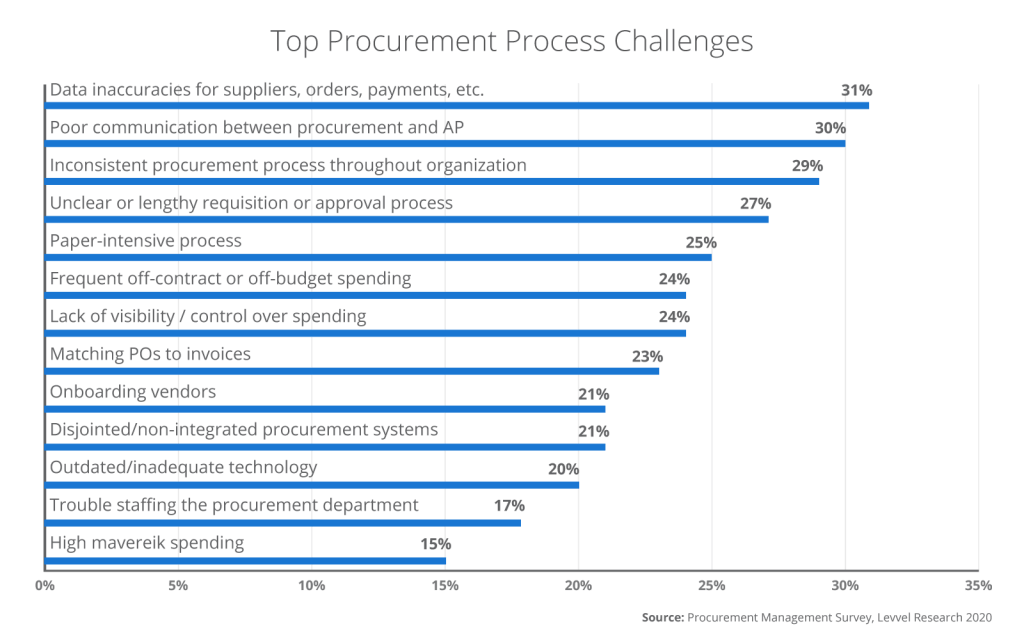For many businesses, making procurement more efficient was about steady, incremental progress over a number of years. Covid and widespread supply-chain interruption changed all that. Now, achieving procurement automation as rapidly as possible has forced itself to the top of corporate agendas.
In our earlier post on the importance of strategic procurement we highlighted how effective procurement means much more than controlling costs. Of course, best pricing plays an important role, but with so many other risk factors to consider in choosing vendors and building optimal relationships with them, procurement processes now need to respond to a complexity of challenges. Moreover, a well-wrought procurement process needs to span the entire organization, which may cross borders and regions as well as the complete operational landscape of the enterprise. Only the sophisticated automation of procurement can hope to address this and capture the benefits that are there for the taking.
Covid accelerating the need for procurement automation
In two specific areas, the pandemic has moved the procurement automation dial more than others.
Firstly, widespread supply chain interruptions caused uncertainty to most businesses. Lockdowns, transport disruption and health impacts to staff and partners all played their part. How many business recorded messages or alerts on their sites have you heard that begin with “due to the impact of covid…”? Businesses that had always been reliable vendors became less dependable for reasons beyond their control.
Meanwhile, changes in customer demand caused havoc to procurement and production planning. If your goods or services were deemed “essential” and/or they could be ordered and delivered online, your business had a better chance of continuity. If not, it could be a matter of survival. Being able to control procurement in this scenario became vital almost overnight.
The second area of pandemic impact was around the ability to carry on operations. Across the globe workers had to stay at home, factories and offices had to close or at best retain a skeleton staff. From being able to speak to colleagues and stakeholders face-to-face, discuss and sort out procurement matters and interact in a way that had always worked before, the new reality became work from home.
WFH demanded far higher levels of process automation across businesses in general and in procurement in particular. If staff were to be able to operate at all, as well as responding to demand and supply-side challenges quickly and effectively, there had to be adequate systems in place. This included remote access tools such as online secure communications and operational systems that could be logged into and worked from home.
Cloud technology has been key to implementing systems remotely and enabling staff to access such systems, regardless of their location. Cloud also offers the flexibility of scaling up or down depending on usage and company growth, something many organizations have needed to take advantage of throughout the pandemic. With cloud just as secure as on-premise and less expensive to manage and maintain, the majority of organizations are now choosing it to host their procurement and accounts payable systems.
In short measure, automation had become imperative and procurement processes were at the eye of the storm.
Old procurement challenges laid bare
In most cases, businesses have tended to have applied some form of IT to their procurement processes. They may use spreadsheets to keep track of orders, deliveries, payments due or outstanding order queries. Those with enterprise resource planning (ERP) systems were likely further along the curve towards automation but both of these displayed severe limitations that the new working environment quickly exposed.
In a recent whitepaper, we explain how even the most comprehensive ERP systems, when used on their own for a high volume of manually handled transactions, will lead to issues such as poor control and visibility over processes and delays in paying vendors. Similarly, according to PYMNTS.com, ERP systems on their own, lack the comprehensive procure-to-pay capabilities necessary for enhancing working capital management, reducing operational costs, improving productivity and rapid invoice and payment processing. For these reasons, organizations are choosing to implement procurement automation solutions that integrate with their existing ERP systems.
In a useful piece of research entitled “2020 Procurement Insight Report,” Levvel, a US-based business technology engineering and consulting firm, graphed the “top procurement process challenges” faced by a cohort of businesses that lacked automated procurement systems. These included:
- Data inaccuracies for suppliers, orders and payments
- Poor communication between procurement and accounts payable departments
- Inconsistent procurement processes throughout the organization
- Unclear or lengthy requisition or approval processes
- Paper-intensive processes
- Frequent off-contract and off-budget spending
- Lack of visibility/control over spending
- Difficulties with managing purchase orders to invoices
- Onboarding vendors
- High maverick spending

Only with a properly wrought procurement automation process will you be able to address all of these problems. In addition, procurement automation brings benefits that are simply not available otherwise, most of which stem from being able to handle and analyze procurement data.
The benefits of procurement automation
1. Control and Visibility
Control and visibility over the procurement process are obvious gains from an enterprise-wide, integrated system. You can easily see where expenditure is taking place, how much and with whom. The larger the organization, the bigger the benefits of such visibility.
The value of speed of action and reaction was something that covid drew attention to. Being able to order goods and services rapidly, or scale back purchases became vital. Governments’ healthcare systems scrabbling for personal protective equipment (PPE) would be a good example. Having the ability to immediately action enterprise-wide purchase decisions with approved vendors, through the use of online vendor catalogs, punch out procedures or requisition templates, are facilities that manual processes cannot achieve efficiently.
2. Controlling Maverick Spend
Controlling maverick spending is a further aspect of this. If there is only one procurement system providing access to approved vendors, with proper approval and authorization protocols installed, informal overrides cannot take place. This plays a significant role in reducing costs and fraud.
3. Fast Approval of Requisitions
An automated procurement system with default approval routes in place will instantly send requisitions to designated approvers as soon as they have been raised. This ensures approval is completed in minimal time and allows essential purchases to be completed quickly
4. Pre-Approved Spend
Pre-approved spend budgets give organizations another option when it comes to the need to make quick purchases. We have already alluded to how the pandemic has forced many into responding to demand and supply-side challenges quickly. With pre-approved spend, budgets can be set for departments to draw down on for spend with approved vendors. This enables essential purchases to be made without delay, given that they do not need to go through the approval process. Spend is also controlled in that budgets cannot be exceeded without approval. As invoices are received for such purchases they will then automatically match with agreed contracts and installment plans, enabling the straight-thru processing of invoices.
5. Vendor Communications
From a vendor’s eye view, a procurement automation system that also incorporates supplier management allows for agreed parameters of operation to be built into the procurement process and provide their business with better controls. They can better plan their procurement, their delivery scheduling and their cash flow. This makes for better customer-vendor relations therefore; approved vendor status confers these benefits and better terms of business should flow from them.
6. Spend Analysis
Lastly, and critically, comes data mining and analysis. Once you can see what the enterprise spends money on, how much and with whom, you can see where economies or scale can be reaped. You can also see where better results can be derived from in terms of avoiding concentrations of risk or dependencies on few or unreliable vendors, for example.
Risk management is a major benefit. Conventionally, payment or credit risk have been well understood by finance and accounts receivable departments but once you integrate procurement automation with the wider business, it becomes clear that businesses depend on vendors as much as cash flow. They are two complementary sides of a business that have tended conventionally (diff word as repeated) to have been lodged in separate operational bunkers. It goes without saying that the financial impacts of more efficient procurement spend also bring financial benefits and these of course can be measured by analyzing procurement data.
Conclusion
In summary, efficient and effective procurement is a science. When you can action, measure, analyze and adjust spending in your business your level of control is of a higher order. The levers at your disposal are more powerful.
Automating procurement enables it to be better aligned with the objectives of the business across the organization as a whole. It also enables a business to be more nimble and reactive to the changing environment in which it operates. The importance of this is something that covid taught us and is still teaching us. No wonder then that procurement process automation has become a c-suite priority in the new normal business world.
Take a look at SoftCo’s Procure-to-Pay solution for more information on the benefits of automating your procurement processes. You can also request a demo of the solution, here.


